

Bing. Blue Planet Biomes - World Biomes. What is a Biome?
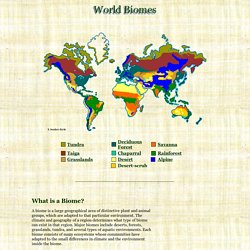
A biome is a large geographical area of distinctive plant and animal groups, which are adapted to that particular environment. The climate and geography of a region determines what type of biome can exist in that region. Major biomes include deserts, forests, grasslands, tundra, and several types of aquatic environments. Each biome consists of many ecosystems whose communities have adapted to the small differences in climate and the environment inside the biome. All living things are closely related to their environment. The earth includes a huge variety of living things, from complex plants and animals to very simple, one-celled organisms. Deciduous Forest. Deciduous biomes are located primarily in the eastern half of the United States, Canada, Europe, parts of Russia, China, and Japan.
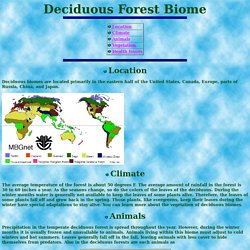
Climate The average temperature of the forest is about 50 degrees F. The average amount of rainfall in the forest is 30 to 60 inches a year. As the seasons change, so do the colors of the leaves of the deciduous. During the winter months water is generally not available to keep the leaves of some plants alive. Animals. Deciduous Forest Climate. Deciduous forest is found in parts of North America, South America, Europe, and Asia, within the latitude 23 degrees north and 38 degrees south.
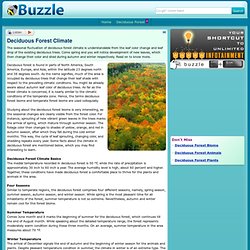
As the name signifies, much of the area is occupied by deciduous trees that change their leaf shade with respect to the prevailing climatic conditions. You might be already aware about autumn leaf color of deciduous trees. Encyclopedia.com articles about Deciduous forests. Earth Floor: Biomes. Deciduous Forest: Plants Trees of this biome include both broadleaf, deciduous trees, such as maple, oak, hickory, and beech, and evergreens, such as hemlock, spruce, and fir.
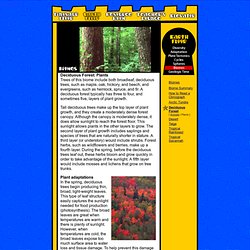
A deciduous forest typically has three to four, and sometimes five, layers of plant growth. Tall deciduous trees make up the top layer of plant growth, and they create a moderately dense forest canopy. Although the canopy is moderately dense, it does allow sunlight to reach the forest floor. This sunlight allows plants in the other layers to grow. The second layer of plant growth includes saplings and species of trees that are naturally shorter in stature. Plant adaptations In the spring, deciduous trees begin producing thin, broad, light-weight leaves. Cooler temperatures and limited sunlight are two climatic conditions that tell the tree to begin adapting. Back | Next. Euxine-Colchic deciduous forests. Sub-regions[edit] The ecoregion is divided into two sub-regions.
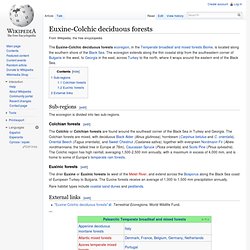
Colchian forests[edit] The Colchic or Colchian forests are found around the southeast corner of the Black Sea in Turkey and Georgia. The Colchian forests are mixed, with deciduous Black Alder (Alnus glutinosa), hornbeam (Carpinus betulus and C. orientalis), Oriental Beech (Fagus orientalis), and Sweet Chestnut (Castanea sativa), together with evergreen Nordmann Fir (Abies nordmanniana, the tallest tree in Europe at 78m), Caucasian Spruce (Picea orientalis) and Scots Pine (Pinus sylvestris). The Colchic region has high rainfall, averaging 1,500-2,500 mm annually, with a maximum in excess of 4,000 mm, and is home to some of Europe's temperate rain forests. Euxinic forests[edit] The drier Euxine or Euxinic forests lie west of the Melet River, and extend across the Bosporus along the Black Sea coast of European Turkey to Bulgaria. Rare habitat types include coastal sand dunes and peatlands. External links[edit]
Forest Threats. Asian longhorned beetle.

Credit: U.S. Department of Agriculture Forests are under attack from invasive species, diseases and unprecedented outbreak of pests, while trying to withstand stress caused by climate change and drought. The Midwest is fighting is the invasive species emerald ash borer, which is killing tens of millions of ash trees. New England has seen tens of thousands of trees succumb to the Asian longhorned beetle, which, if it spreads, is estimated to be able to destroy 30 percent of the country’s hardwoods. Each threat to forests requires us to take a unique approach to solving it. Through American Forests Global ReLeaf, we work to replant trees, including disease-resistant trees, in areas harmed by disease, insects and more. View our tree plantings to alleviate the effects of forest threats. A mountain pine beetle excavating a tunnel in a ponderosa pine.
Discover our Endangered Western Forests work in the Greater Yellowstone Area. Kids' Games, Animals, Photos, Stories, and More. Temperate Deciduous Forest Animal Printouts. Advertisement.

EnchantedLearning.com is a user-supported site. As a bonus, site members have access to a banner-ad-free version of the site, with print-friendly pages.Click here to learn more. (Already a member? Click here.) Temperate Deciduous Forest Animal Printouts Temperate deciduous forests are forests in cool, rainy areas; they have trees that lose their leaves in Fall and regrow them in Spring. Temperature and Precipitation: The average temperature in temperate deciduous forests is roughly 75°F (24°C) but gets as high as 86°F (30°C), depending on the altitude of the forest.